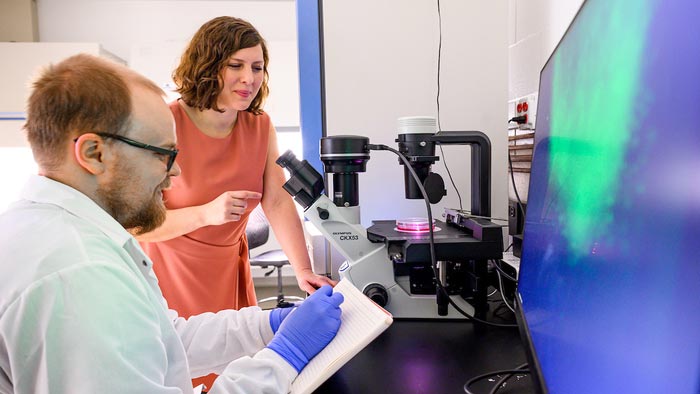Low-cost, portable device could diagnose heart attacks in minutes

Pinar Zorlutuna talks with one of her graduate students in her lab.
Photo by Matt Cashore/University of Notre Dame
Researchers from the University of Notre Dame and the University of Florida have developed a sensor that could diagnose a heart attack in less than 30 minutes, according to a study published in Lab on a Chip.
Currently, it takes health care professionals hours to diagnose a heart attack. Initial results from an echocardiogram can quickly show indications of heart disease, but to confirm a patient is having a heart attack, a blood sample and analysis is required. Those results can take up to eight hours.
“The current methods used to diagnose a heart attack are not only time intensive, but they also have to be applied within a certain window of time to get accurate results,” said Pinar Zorlutuna, the Sheehan Family Collegiate Professor of Engineering at Notre Dame and lead author of the paper. “Because our sensor targets a combination of miRNA, it can quickly diagnose more than just heart attacks without the timeline limitation.”
By targeting three distinct types of microRNA or miRNA, the newly developed sensor can distinguish between an acute heart attack and a reperfusion — the restoration of blood flow, or reperfusion injury, and requires less blood than traditional diagnostic methods to do so. The ability to differentiate between someone with inadequate blood supply to an organ and someone with a reperfusion injury is an unmet, clinical need that this sensor addresses.
“The technology developed for this sensor showcases the advantage of using miRNA compared to protein-based biomarkers, the traditional diagnostic target,” said Hsueh-Chia Chang, the Bayer Professor of Chemical and Biomolecular Engineering at Notre Dame and co-author of the paper. “Additionally, the portability and cost efficiency of this device demonstrates the potential for it to improve how heart attacks and related issues are diagnosed in clinical settings and in developing countries.”
A patent application has been filed for the sensor and the researchers are working with Notre Dame’s IDEA Center to potentially establish a startup company that would manufacture the device.
Bioengineers Chang and Zorlutuna are both affiliated with Notre Dame’s Institute for Precision Health. Additional co-authors from Notre Dame are Stuart Ryan Blood, Cameron DeShetler, Bradley Ellis, Xiang Ren, George Ronan and Satyajyoti Senapati. Co-authors from the University of Florida are David Anderson, Eileen Handberg, Keith March and Carl Pepine. The study was funded by the National Institutes of Health National Heart, Lung, and Blood Institute.
To read the full study published in Lab on a Chip, a journal from the Royal Society of Chemistry, and featured on the back outside cover, visit https://pubs.rsc.org/en/content/articlelanding/2021/lc/d1lc00685a.
Media Contact
Jessica Sieff
University of Notre Dame
jsieff@nd.edu
Office: 574-210-4554
All latest news from the category: Medical Engineering
The development of medical equipment, products and technical procedures is characterized by high research and development costs in a variety of fields related to the study of human medicine.
innovations-report provides informative and stimulating reports and articles on topics ranging from imaging processes, cell and tissue techniques, optical techniques, implants, orthopedic aids, clinical and medical office equipment, dialysis systems and x-ray/radiation monitoring devices to endoscopy, ultrasound, surgical techniques, and dental materials.
Newest articles

Innovative 3D printed scaffolds offer new hope for bone healing
Researchers at the Institute for Bioengineering of Catalonia have developed novel 3D printed PLA-CaP scaffolds that promote blood vessel formation, ensuring better healing and regeneration of bone tissue. Bone is…

The surprising role of gut infection in Alzheimer’s disease
ASU- and Banner Alzheimer’s Institute-led study implicates link between a common virus and the disease, which travels from the gut to the brain and may be a target for antiviral…

Molecular gardening: New enzymes discovered for protein modification pruning
How deubiquitinases USP53 and USP54 cleave long polyubiquitin chains and how the former is linked to liver disease in children. Deubiquitinases (DUBs) are enzymes used by cells to trim protein…



